Bringing together football die-hards, casual fans, and party lovers, the Super Bowl is one of the biggest and most watched events in the United States…but is it becoming a global event?
In recent years the NFL (National Football League) has been working to expand their audiences globally by holding regular season games in countries like the UK, Germany and Mexico. So, Kantar set out to explore how people perceive the event today.
Kantar recently surveyed 3,000 people online across the US, UK, and Canada from its Profiles Audience Network, looking at event perceptions, why people watch it, and opinions around advertisements.
Here are some of our key findings.
Top 3 sports to follow
In the US, the most watched sport is American football (44%). This is followed by basketball (11%) and baseball (9%). While this survey was conducted during the FIFA World Cup 2022, only 7% of people in the US say they watch soccer the most.
Half of people in the UK favor soccer, with only 3% reporting they watch American football the most. In Canada, 13% say American football is their preferred sport, however, hockey is the most popular (29%).
The Super Bowl has a substantial audience base overseas, including NFL fans and casual ones
When asked if they consider themselves a fan of American football, 19% in the UK say they follow the NFL regularly. Compared to the UK, NFL fans account for 54% of the US respondents and 31% of the Canadians.
While the percentage of American football fans in the UK is the lowest among the 3 countries, 22% in the UK say they still watch the Super Bowl even though they are not NFL fans. This is close to the percentage of nonfans tuning in for the Super Bowl in the US (23%).
49% of people in the UK and 69% in Canada say they watch the Super Bowl at least occasionally – 86% say the same in the US. 60% in the US watch it every year, while only 23% in the UK and 38% in Canada do. Over half of the respondents (51%) in the UK have heard of the event, but have never watched it.
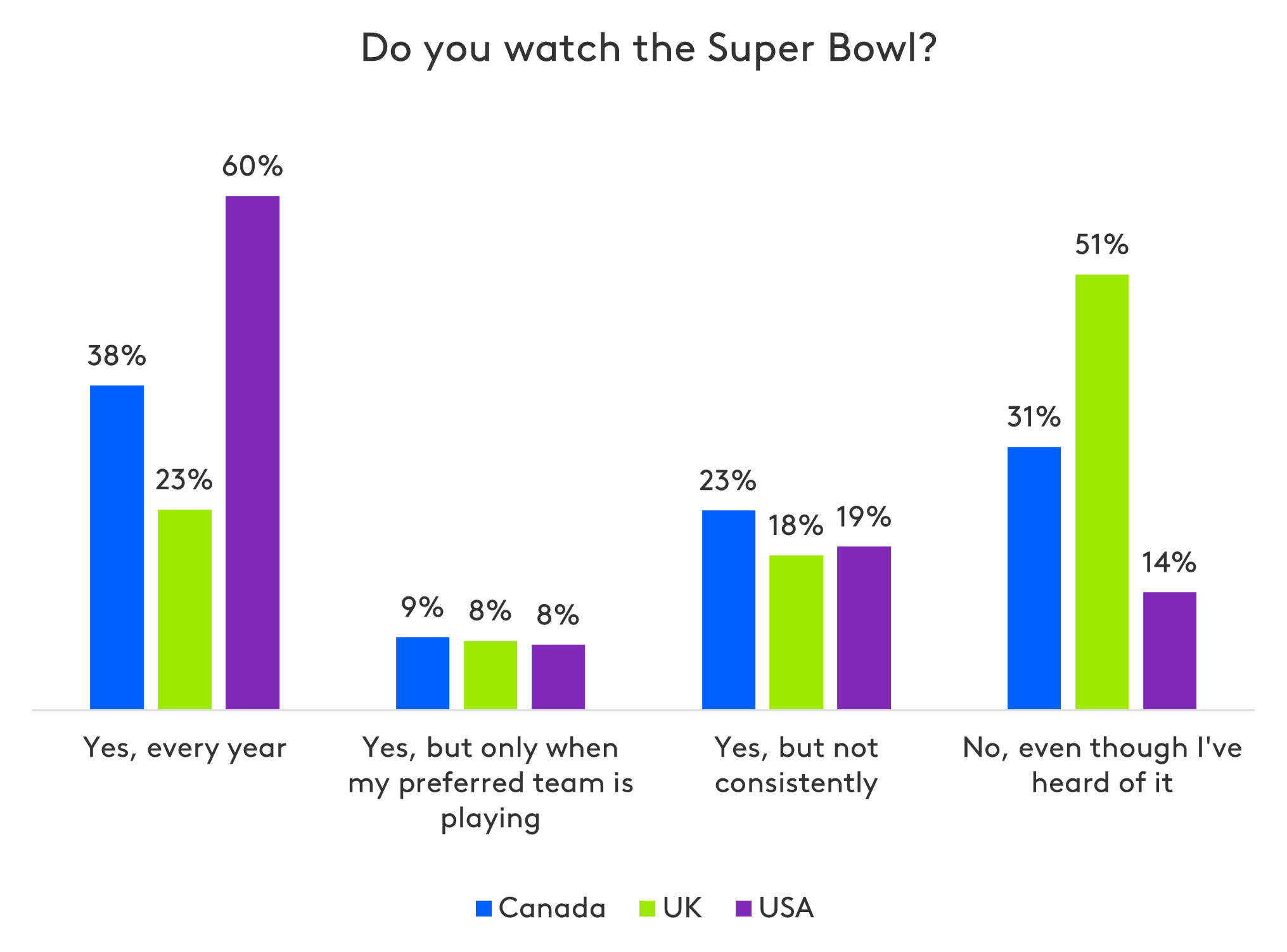
All countries think that it’s an American event, but younger generations are more likely to consider it global
The majority of respondents interviewed across the three countries agree that the Super Bowl is an American event. The US felt this the strongest (81%), while Canada felt it the least (69%).
While all countries think that the Super Bowl is “American”, younger generations are more likely to view it as a "global” event. The survey finds that 29% of people aged 18-35 think that the Super Bowl is a global event, but only 19% of those over 56 years think the same.
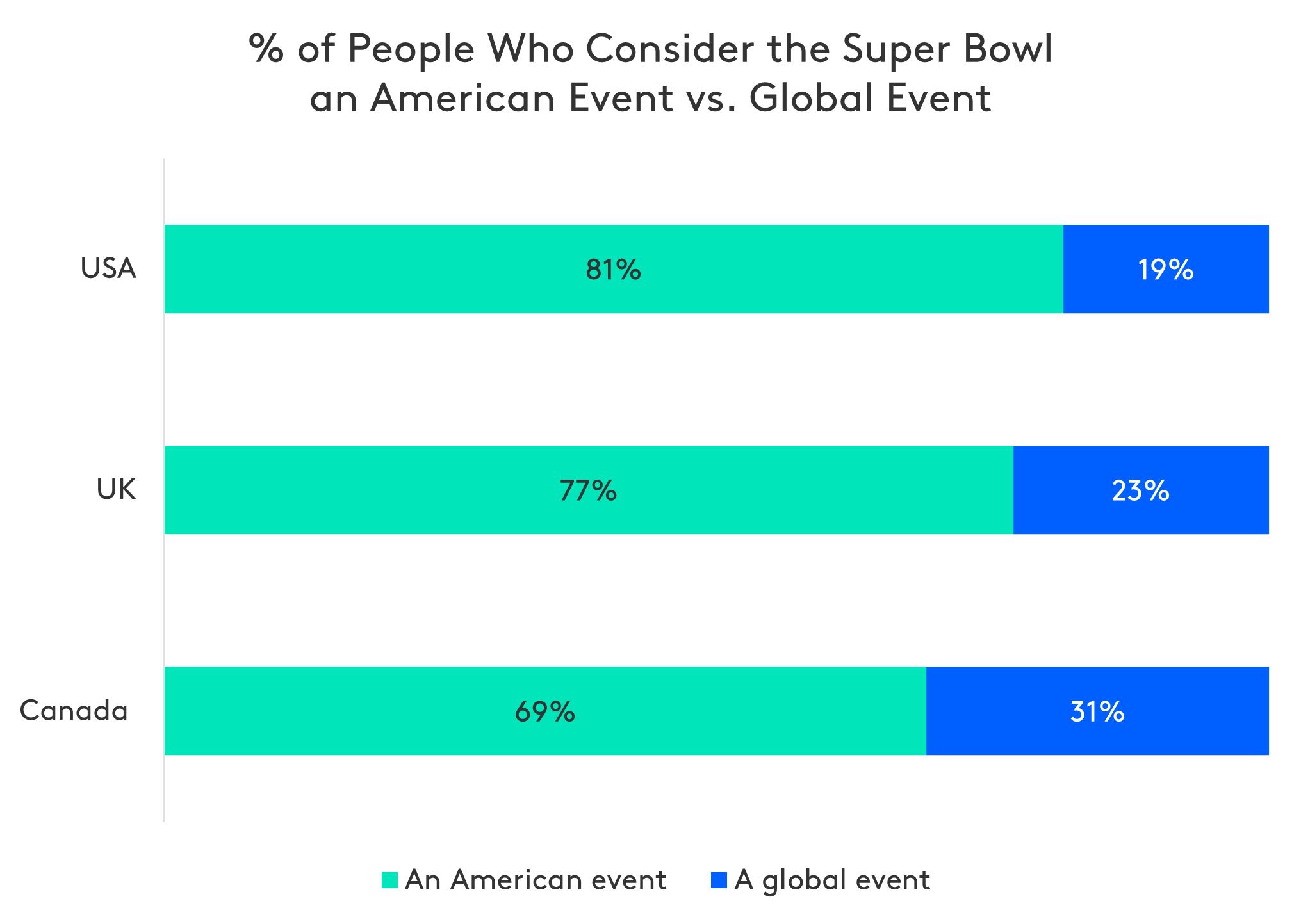
All countries think that it’s a sporting event vs. an entertainment event
When asked whether they consider the Super Bowl as a sporting event versus an entertainment event, most people in all three countries agree that it is a sporting event: 68% in the UK, 65% in the US, and 63% in Canada.
More women (38%) think that the Super Bowl is an entertainment event than men (31%).
Most US viewers watch the game live on TV, only 50% in the UK do
Among Super Bowl viewers, 85% in the US watch it live on TV broadcast, versus 70% in Canada and 50% in the UK. International viewers are more likely to watch it live online, 29% and 22% in the UK and Canada respectively. This is 2-3 times more than the percentage of online viewers in the US (11%).
Generationally, younger people are more likely to watch it live online, with 30% of viewers aged 18-35 preferring this. The percentage drops as the age increases. Only 19% of viewers aged 36-55 and 7% of viewers older than 56 years watch it live online.
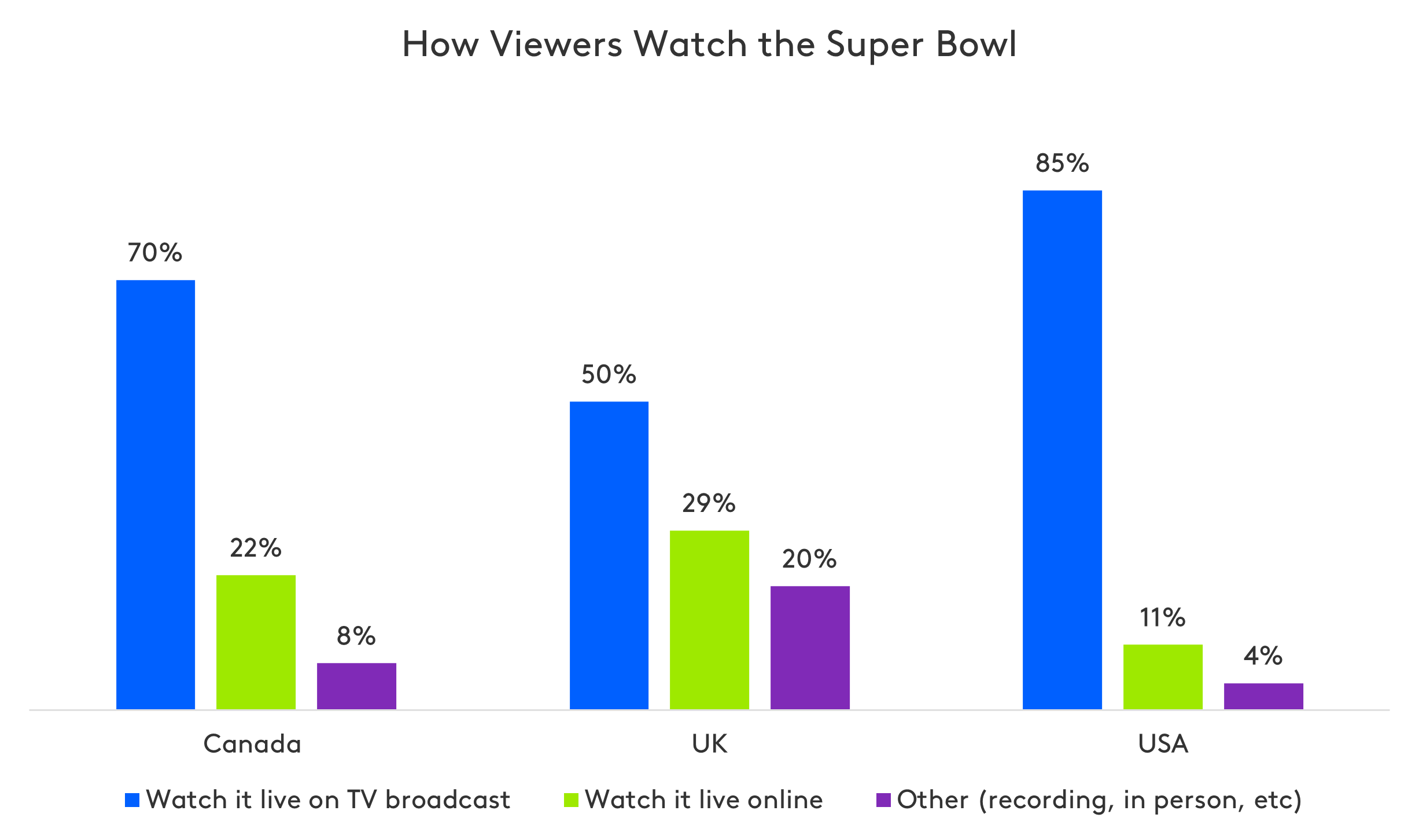
Top reasons for watching the Super Bowl
While the most popular reason to watch the Super Bowl across all countries is to purely enjoy the game (43%), 24% say they watch the game because their families and friends do. From an entertainment perspective, 26% report that the halftime show is a major draw, while the commercials are only cited as a reason to watch the game by 17% of viewers.
Outside enjoying the game, the top 3 reasons for watching the Super Bowl across countries vary. Canada and UK viewers’ second reason is the halftime show (Canada 29% and UK 25%). 26% of the viewers in the US tune in to see the ads. Advertisement is not one of the top three reasons in the UK or Canada. Nearly 1 out of 5 viewers in the UK say they watch the Super Bowl out of curiosity.
More than half of Super Bowl viewers host or go to parties
Across all three countries, most viewers watch the Super Bowl at parties: around 22-26% host parties and another 36-38% go to parties hosted by others. The US has the highest percentage of party hosts (26%) among the viewers. 39% in the US, 38% in Canada, and 36% in the UK go to the Super Bowl parties hosted by others.
Commercials are a big part of the experience and people pay attention to them
While only 17% say commercials are a reason to tune into the game, all countries believe they are a big part of the experience (76-91%) and 82-94% of viewers actively watch them during at least some of the game.
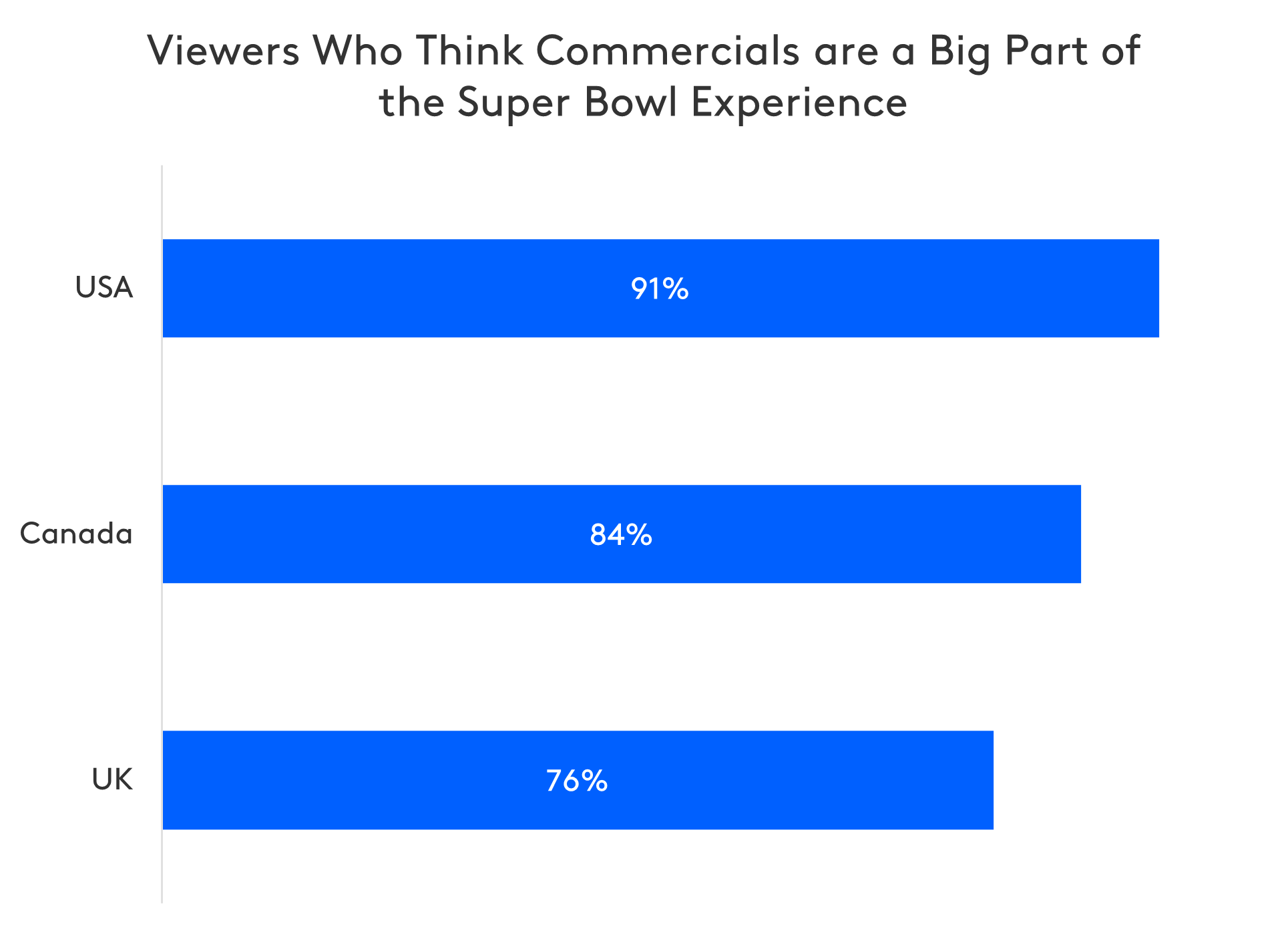
Audiences expect ads to be funny and entertaining
Across all three countries, 52% of Super Bowl viewers say the ads catch their attention because they are funnier or more entertaining than normal ads. The US has the highest percentage of people paying attention to the ads because of this (61%). 54% in Canada and 32% in the UK feel the same way
When asked what types of commercials resonate the most, 72% of those who watch the ads in the US and 63% in Canada say funny ads do. Among UK viewers, entertaining ads resonate the most.
In all three countries, being funny and entertaining wins consumers over emotional ads or those with new ideas.
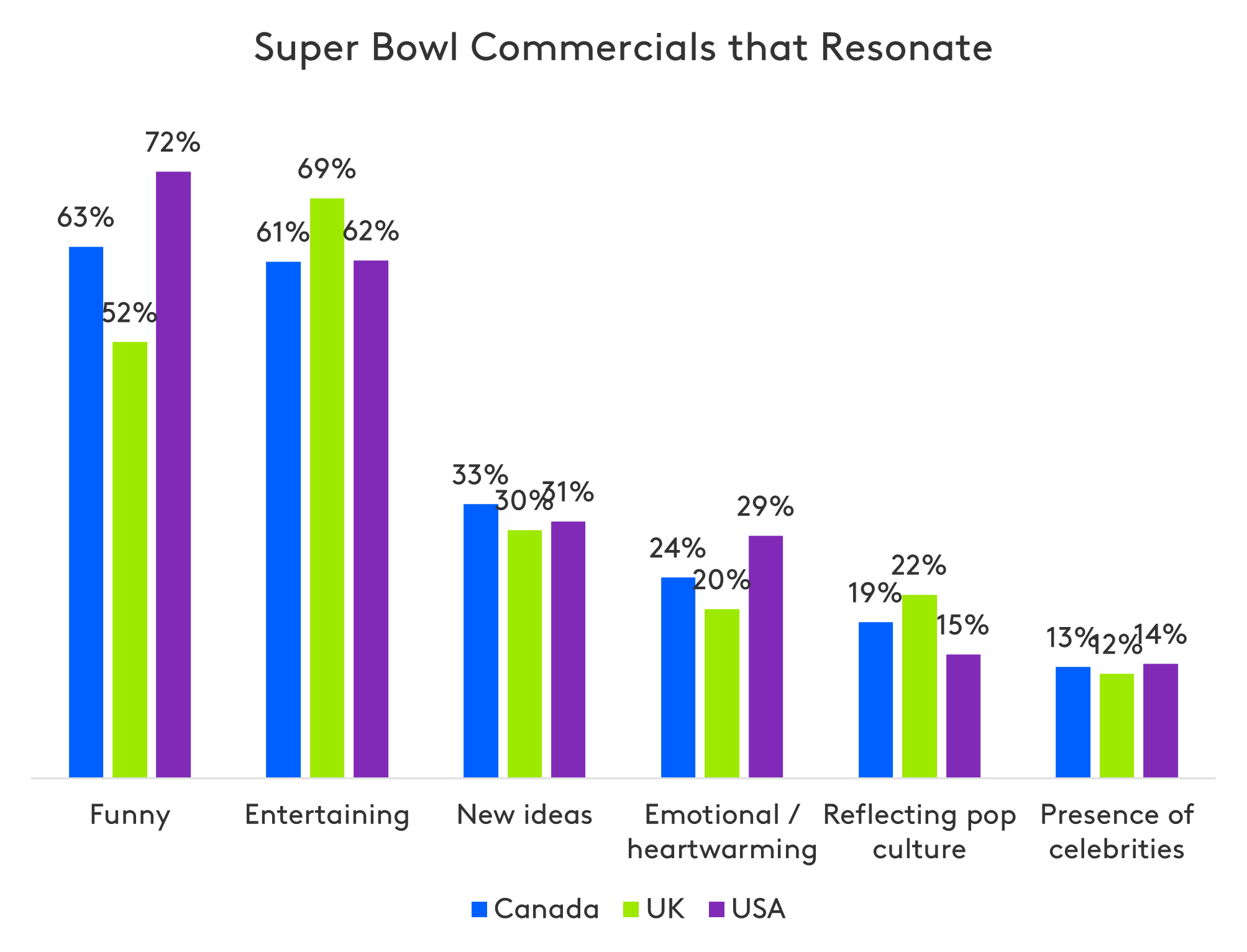
Audiences like when brands release pre-game Super Bowl commercials
In recent years, it’s become popular for brands to release teasers for their Super Bowl campaigns prior to the game day. While many people who watch the game-day ads like this (48%), not all appreciate the spoiler (20%).
More people like the early look in the UK (51%) and Canada (55%) than in the US (41%). US viewers dislike the practice the most (24%), compared to UK and Canada.
About this study
This research was conducted online among 3,000 people across three countries: US, UK and Canada based on local age and gender census distributions.
Respondents were sourced from the Kantar Profiles Audience Network and powered by Accelerated Answers. All interviews were conducted as online self-completion between 12 and 14 December 2022.
Subscribe to get more insights like this
Have the latest consumer insights powered by Kantar Profiles Audience Network and business updates from Research Services delivered to your inbox. Sign up using the form below to stay informed.
